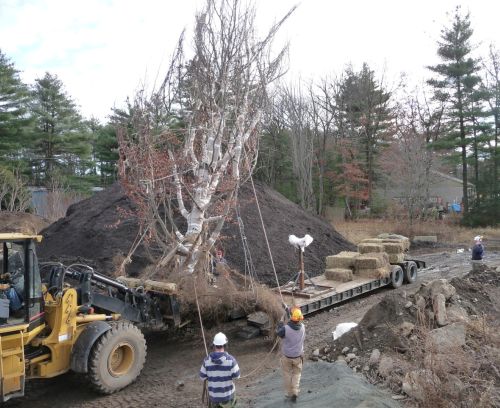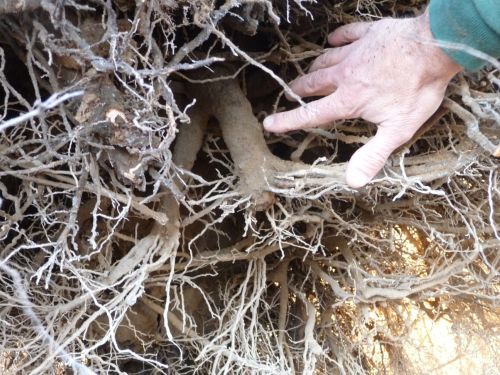This year’s New England Grows featured a talk by Jim Flott, who discussed the bare-root transplanting of large trees. Jim talked about root-washing, something he has studied, practiced, and taught, on his own and with the late Bonnie Appleton of Virginia Tech. He spoke about the history of bare-root transplanting — until the middle of the 1900s bare-rooting was the primary way to transplant trees — and about bare-rooting with air tools. It was a great presentation; this abstract by Flott and Appleton covers a lot of the territory Jim discussed, and it’s worth a read.
Bare-root transplant with air tools — 12″ caliper London Plane tree, moved in late July 2009 in Wellesley, MA.
After Jim’s talk in one of the large auditoriums, he moved to a smaller room for an ‘Speaker Unplugged’ session, where people could ask him questions and exchange information. As had happened at New England Grows three years ago, when Matt Foti discussed bare-root transplanting with air tools, someone asked about the effects of bare-root transplanting on a tree’s taproot.
How does bare-root transplant affect a taprooted tree? The answer, both from Jim and from Matt, is that taproots are rarely an issue.
A taproot typically forms when a seed germinates; the baby taproot emerges first from the seed, growing down and anchoring the seed in the soil. Next, the cotyledon shoot emerges and grows upward. As the cotyledon starts to photosynthesize, root hairs branch out from the taproot, and the root volume grows and spreads. The depth of roots is determined in part by available moisture and in part by soil type. Typically, organic soils — which hold water and allow good cation exchange — rest at the top of the soil profile; mineral soils underlie the organic horizons, and are much less hospitable to roots. Here in New England soils may be quite thin, and are often underlain with rock.
So taproots here will serve that useful anchoring function early in a tree’s life, but soil conditions and the plant’s own tendencies will promote the outward, rather than the downward growth of a tree. In fact, the overall growth of tree roots tends to be outward, rather than down; the old image of a root mass volume and form mirroring a tree’s crown volume and form has been proven false.
We know that trees tend to develop their roots in the top 18″ of soil; the larger the tree, the deeper that zone may go, but typically it extends no more than 3 or 4 feet below grade. Some thick roots on very large trees may extend vertically down in this zone, if soil conditions permit, but many more run horizontally away from the tree’s trunk. The anchoring function of that original taproot, if it remains, is replaced by the anchoring provided by a much broader and more extensive mass of roots growing out and (to a much less extent) down.
As I wrote in an earlier post (with thanks to Linda Chalker-Scott for its title):
It’s helpful to keep in mind another factor when thinking about taproots and transplanting trees. More often than not, a large tree being transplanted was planted out years earlier as a B&B plant, or possibly moved into place with a tree spade. Both methods would have cut any taproot in the initial planting. When the end of a root is cut, the tree tends to send shoots out from just above the cut end. In a vertically oriented root, the new shoots are apt to extend horizontally from the cut end, and feeder roots would similarly extend out horizontally. The situation may well be different for a tree that has grown from seed in one place, that someone now wants to transplant bare root, but for most landscape trees the taproot issue is moot — whatever taproot may have existed when the tree seed germinated has already been cut, and the tree has adjusted for its loss.
A carrot grows downward, with rootlets out to the side and foliage above ground. A tree is not a carrot. Photo by obenson in Flickr.
This beech tree was moved last fall, having been transplanted once about 20 years ago. See how the root mass extends far out horizontally, with a relatively shallow depth.
This is one of the thickest roots extending vertically from the beech’s trunk. This root was cut in the earlier (20 years previous) transplant; note the resultant root growth just above the cut.










